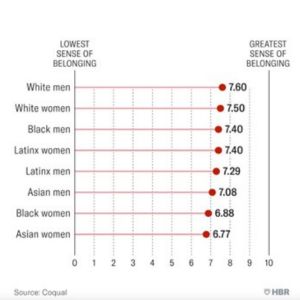
 Lyn Turknett,
Co-founder and Co-chair, TLG
Lyn Turknett,
Co-founder and Co-chair, TLG
We have always believed that a culture that makes every member of the organization feel included, one where everyone feels heard and everyone feels able to speak up, is a culture that leads to both high engagement and high performance. We also know, though (and we’ve seen it in our own engagement surveys), that in most organizations white men feel the highest sense of belonging, followed by white women. Black and Asian women feel the lowest sense of belonging. Research by Coqual, a nonprofit think tank focused on promoting diversity, equity, and inclusion, has confirmed that very recently. The chart below is from an HBR article authored by Coqual leaders.

Right now, research on psychological safety is exploding, and that concept is powerful in helping us all create cultures that help everyone feel that they belong. Amy Edmonson, author of “The Fearless Organization,” is the leading scholar on psychological safety. Interest exploded when Google research demonstrated that their highest-performing teams were primarily distinguished by one thing – higher psychological safety. Research by Shannon Harmon, a Ph.D. psychologist and Senior Advisor, Operational Excellence at Southern California Edison, shows that supportive leadership has a positive influence on psychological safety. Directive leadership has a negative influence. Directive leadership is often necessary, of course, but it must be balanced by supportive leadership. In the lingo of our Leadership Character Model, that means balancing Respect and Responsibility in every moment.
Harmon also found, in a very large study within the electric utility, that psychological safety is also critical for lowering accidents – it promotes a safety culture… We know that’s true in healthcare and aviation as well. In environments where safety is a matter of life and death, real inclusion, and the feeling of belonging that implies, is the key to open communication and accident avoidance.
Listening Leads to Change
We’ve seen many, many leadership transitions – at the top of companies and in large departments and divisions. In every instance, when those are successful – when they lead to sustained and positive culture change, improved performance, improved engagement, and increased inclusion – the leaders begin by listening. They talk to individuals, they hold town halls, they eat in the cafeteria with everybody else, they start engagement surveys, they are open to feedback and criticism, and they make it clear that they are human.
We worked with Hewlett Packard when David Packard and Bill Hewlett were still leading the company. I’ll never forget a leader we were working with telling us that the founders would be as likely as anyone else in the room to crawl under a table to plug in a cord that had become unplugged. I’ve never forgotten that image.
Creating a Bigger Table
We have seen so many examples of leaders stepping up to create more inclusive workplaces, and, as mentioned earlier, every truly effective new leader I’ve ever seen always begins with a strategy of listening – of making everyone feel heard. While we think of inclusion and belonging as most needed for those who are marginalized, belonging is simply a core human need. And NO PERSON working in a culture of fear and intimidation can do their best work or create a safe environment for customers or patients. A foundation of character is essential.
I thought about one of the largest transitions I’ve seen – one that took place over twenty years ago. We were working with a very larger telecommunications firm, BellSouth, and Rod Odom had taken over as president of the network organization, the part of the company that included all the technicians, engineers, and construction crews that built the infrastructure and kept the system up and running.
He really wanted to transform the culture of the organization – an organization that was about 35,000 people strong. He focused on two things: he wanted to personally lead in a way that was less hierarchical and more respectful, and he wanted his front-line supervisors to do the same. What he did reminded me of what Alan Mulally did at Ford. He took an engineering culture that was heavily focused on measurement and accountability (but one that was sometimes more focused on making the numbers look good than being accurate and helpful) and added humanity.
Small Moments
Geographically the network was spread over nine southern states, and Rod would spend a lot of time in the field visiting local centers. Rod was a fan of the Leadership Character Model, but he did more than talk about it – he tried to live it. Something he said once in conversation stuck with me. He said something like, “Most leaders who have been in my role, when they go out to local centers, they pull together the crews and talk to them from the bed of a pickup truck. I decided the look of that sends the wrong message. I’m just standing on the ground – we’re all in this together.”
That’s a small thing, but every culture is built on small moments.

